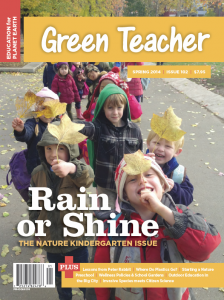Green Teacher 102, Spring 2014
 Purchase this issue or subscribe
Purchase this issue or subscribe
Subscriber access
Features
Why a Nature Kindergarten? by Claire Warden
No matter where or for how long, young children stand to benefit from spending extended time outdoors
Embodying Permaculture by Matthew Bibeau and Kelly Hogan
Once a buzzword amongst the gardening community, the principles of permaculture are now being applied to early childhood education
Ten Steps for Starting a Nature Preschool by Jessica Pierson
Keen on the idea of starting a nature preschool? Not so fast. These ten suggestions detail what you need to know before moving ahead
Risk Assessing Outdoor Areas by Rosa Barcotti
Young students learn to assess their own abilities and limitations by playing on an icy snow hill
Look Up and Listen by Catherine Koons Hubbard (Free article)
Preschool students find peace and serenity in the woods
The Kinder-Gardeners by Mark DeBoer (Free article)
It hasn’t been easy getting going but here’s a dynamic outdoor kindergarten in a public school smack dab in the middle of the fourth largest city in North America
Marvelous Migration by Michael J. Caduto
Exploring the seasonal movements of birds through story and science
Developing Character through Ancient Wisdom by Cheri Isgreen
Use Aboriginal and historical knowledge to develop character and a sense of community among students of all ages
Where Does the Plastic Go? by Christopher D. Murakami, Suleyman Cite, Dane L. Schaffer, and Troy Sadler
Using Socio-Scientific Issues in the classroom to study plastic pollution in the ocean and the physical properties of plastics
Let Peter Rabbit Play in the Garden by Kelly Johnson
Using Beatrix Potter to integrate ecological literacy into elementary classrooms
Creating School Gardens that Last by Jennica Skoug and Beth Hanna
Wellness policies can help ensure school gardens remain vibrant and vital long into the future
Tackling Invasive Species Using Citizen Science by Sarah Morrisseau and Christine Voyer
An online network of thousands of students and teachers can extend scientist’s otherwise limited research and monitoring efforts
Leave a Reply
You must be logged in to post a comment.





